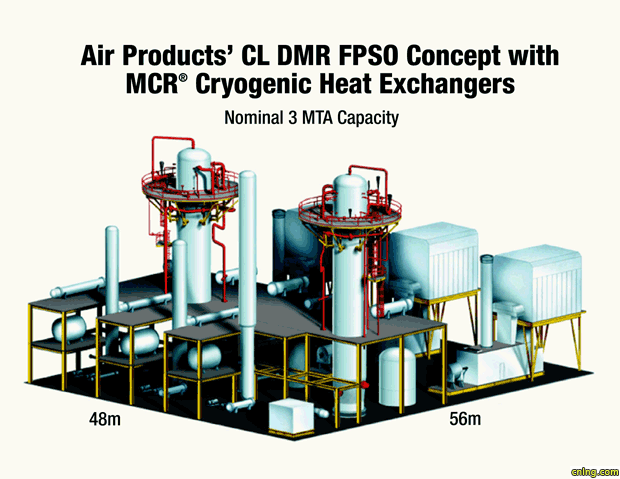The key to our success has been Air Products' MCR® liquefaction process and the MCR® cryogenic heat exchanger (MCHE). Air Products' unique ability to integrate the liquefaction process design and the mechanical design of the main cryogenic heat exchanger leads to an optimization of performance and reliability that has become the benchmark of the LNG industry. This ability is even more crucial in a floating, production, storage, and off-loading (FPSO) LNG plant where the added dimensions of efficient use of deck space and the safe and efficient operation of process equipment under wave motion are of key importance.

Air Products' CL DMR FPSO Concept with MCR® Cryogenic Heat Exchangers
For capacities of less than 1 MTA:
Air Products' AP-MTM Modular Refrigerant Process is Ideal for Small Stranded Gas Reserves
Air Products' AP-MTM modular processes fit the requirements of the small scale FPSO LNG plant.
For capacities for 0.5 – 6 MTA:
Air Products' Dual Mixed Refrigerant Process is Highly Efficient, Economical and Compact
Air Products' dual mixed refrigerant (DMR) processes fit the requirements of the FPSO LNG plant. The refrigeration for the precooling is supplied by a closed loop mixed refrigerant system. The refrigeration for the liquefaction and subcooling is supplied by another, separate, closed loop mixed refrigerant system, the same MCR® process that has been the standard of the baseload LNG industry. The precooling MCR® system and the liquefaction MCR® system are separate and distinct circuits. The mixed refrigerant composition for each is optimized for the cooling temperature range being covered. The process efficiency approaches that of the propane precooled MCR® cycle used in the overwhelming majority of the world's baseload LNG plants while reducing the number of components and the deck space required for liquefaction equipment.
The following illustration depicts a nominal 3 MTA FPSO plant incorporating two wound coil heat exchangers and three GE LM6000 gas turbine driven compressors contained within a 56 x 48m deck area. One of the exchangers is used for precooling service, replacing the more traditional propane precooling equipment. The second exchanger provides final liquefaction and subcooling of the LNG.
For capacities greater than 6 MTA:
Air Products' AP-XTM LNG Process is Highly Efficient, Economical for Larger FPSO Applications.
Air Products' AP-XTM process fits the requirements of the large scale FPSO LNG plant using a dual mixed refrigerant for pre-cooling and liquefaction.
Air Products' LNG Processes are Safe, Reliable, Flexible, Efficient and Easy to Operate
Air Products developed the MCR® process for natural gas liquefaction in baseload service. This system provides cooling at a continuum of temperature levels to liquefy the natural gas feed stream. By using a mixture of gases rather than single refrigerant components, the thermodynamic efficiency of the process is enhanced and the liquefaction system is greatly simplified. The renowned propane-precooled MCR® process has been the process of choice for the baseload LNG industry because it has proven to be reliable, flexible, thermodynamically efficient and easy to operate. The application of mixed refrigerant precooling has special attraction for an FPSO application since the number of equipment items can be reduced while matching baseload efficiencies. Using a mixed refrigerant also reduces the safety risks that some clients may associate with the volumes of propane required for propane precooling.
Air Products' LNG Specialists Will Optimize the Capital and Deck Space Invested to Yield the Greatest Return in LNG Production
Air Products' LNG specialists can assist in the early stage of project development by conducting process scoping studies and preliminary process designs to assist the FPSO owner in developing a sound design basis.
Air Products' engineers can develop an optimized precooling and liquefaction system that integrates the main cryogenic heat exchangers with the refrigerant compressor/driver sets and the supporting process equipment. This allows the capital and deck space invested in compressor/driver sets to yield the greatest return in LNG production.
The dual MR process also offers tremendous flexibility in exchanger and compressor design. The process can be configured to minimize hydrocarbon inventories, eliminate specific components from the MCR mix, if desired, for safety reasons or to meet the weight and center of gravity requirements of a specific FPSO vessel design. These considerations as well as the more traditional project-specific parameters, such as site-specific ambient conditions, feed characteristics, production requirements and economic factors are properly balanced with each client's needs to engineer the most cost-effective system for each project.


